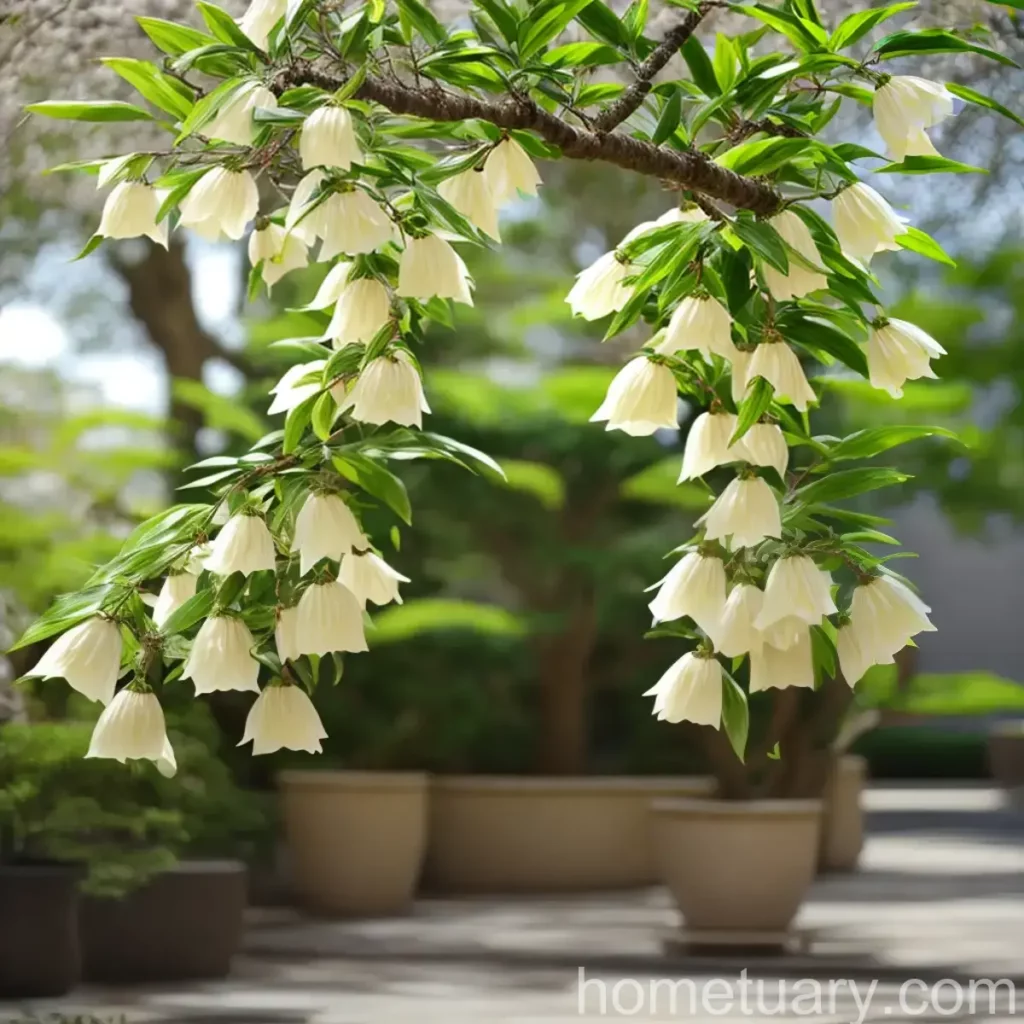Plant Scientist’s Guide to Furin-Tsutsuji (Enkianthus campanulatus)
Enkianthus campanulatus, commonly known as furin-tsutsuji, is a fascinating ornamental shrub that belongs to the Ericaceae family. This plant is native to East Asia and is popular for its delicate bell-shaped flowers and vibrant fall foliage. As a plant scientist with a passion for exploring the diversity of plant life, I am excited to delve into the enchanting world of furin-tsutsuji and provide valuable insights into its cultivation, care, and uses.
What is Plant Furin-Tsutsuji (Enkianthus campanulatus)?
Furin-tsutsuji, or Enkianthus campanulatus, is a deciduous shrub renowned for its attractive appearance and ornamental qualities. The name “Enkianthus” is derived from the Greek words “enkyos” (pregnant) and “anthos” (flower), alluding to the flower structures of this genus. The species name “campanulatus” is a reference to the bell-shaped flowers, which are a distinctive feature of this plant.
The plant is characterized by its graceful, arching branches and its ability to thrive in acidic, well-draining soils. Furin-tsutsuji is typically grown for its striking display of pendulous, bell-shaped flowers that appear in late spring to early summer, adding a touch of elegance to gardens and landscapes. In addition to its floral beauty, this shrub boasts vibrant fall foliage, with leaves transforming into captivating shades of red, orange, and yellow, making it a captivating sight in autumn.
Key Takeaways – Furin-Tsutsuji (Enkianthus campanulatus)
Before we delve deeper into the cultivation and care of furin-tsutsuji, let’s highlight the key takeaways that encapsulate the essence of this enchanting plant:
- Scientific Name: Enkianthus campanulatus
- Common Name: Furin-tsutsuji
- Flowering Period: Late spring to early summer
- Fall Foliage Colors: Red, orange, yellow
- Growth Habit: Deciduous shrub with arching branches
- Acidic Soil Requirement: Well-draining, acidic soil
- Ornamental Features: Bell-shaped flowers, vibrant fall foliage
- Landscape Use: Gardens, landscapes, ornamental borders
In the following sections, we will explore the culture, uses, and detailed care requirements of furin-tsutsuji to enable both novice and seasoned gardeners to cultivate and appreciate this captivating plant.
Culture
Cultivating furin-tsutsuji requires an understanding of its specific environmental and soil requirements. Let’s explore the cultural aspects that contribute to the successful growth and development of this ornamental shrub.
Uses
Furin-tsutsuji holds a special place in horticulture due to its diverse uses and ornamental value. Whether employed as a focal point in a garden or as part of a mixed border, its striking features and adaptability make it a versatile addition to any landscape. Let’s explore the various uses of furin-tsutsuji.
Landscape Use
- Gardens: Furin-tsutsuji can be used in both formal and informal garden settings, where its graceful form and striking flowers can create eye-catching displays. Whether planted individually or in groups, it adds a touch of elegance to the landscape.
- Ornamental Borders: Incorporating furin-tsutsuji into ornamental borders can provide a stunning backdrop for other perennials and shrubs, enhancing the overall visual appeal of the garden.
Seasonal Interest
- Spring Bloom: The bell-shaped flowers of furin-tsutsuji herald the arrival of spring, making it a captivating sight during this time of renewal and rejuvenation.
- Fall Foliage: As autumn approaches, the deciduous leaves of furin-tsutsuji undergo a spectacular transformation, turning into fiery hues of red, orange, and yellow, providing a visual treat for garden enthusiasts.
Water
Proper watering is essential for the overall health and vitality of furin-tsutsuji. As with most plants, striking the right balance in moisture levels is crucial for optimal growth and flowering. Here are some guidelines for ensuring adequate hydration for furin-tsutsuji.
- Establishment Period: During the initial establishment phase after planting, it is important to provide regular watering to facilitate root development and acclimatization to the new environment.
- Soil Moisture: Furin-tsutsuji thrives in well-draining soil that retains moisture without becoming waterlogged. Regular monitoring of soil moisture levels is recommended, especially during dry spells.
- Mulching: Application of a layer of organic mulch around the base of the plant helps conserve soil moisture and suppress weed growth, contributing to a healthy growing environment for furin-tsutsuji.
Sunlight
Sunlight plays a pivotal role in the growth and flowering of furin-tsutsuji. Understanding its sunlight requirements is key to ensuring that the plant receives the optimal amount of light for vigorous growth and abundant blooms.
- Light Conditions: Furin-tsutsuji performs best in partial shade to full sun, with dappled sunlight being an ideal condition for its overall growth and flowering.
- Morning Sun: The plant benefits from receiving morning sunlight, which provides the necessary energy for photosynthesis while offering protection from the intense heat of the afternoon sun.
- Shade Tolerance: While it appreciates some direct sunlight, furin-tsutsuji also exhibits a degree of tolerance to shaded conditions, making it suitable for planting in areas with varying light intensities.
Fertilizer
Appropriate fertilization is essential for promoting healthy growth, abundant flowering, and vibrant foliage in furin-tsutsuji. By providing the necessary nutrients, gardeners can support the overall vitality of the plant and enhance its ornamental appeal.
- Acidic Fertilizer: Given furin-tsutsuji’s preference for acidic soil, it is beneficial to use a fertilizer specifically formulated for acid-loving plants. This ensures that the plant receives the essential nutrients while maintaining the optimal soil pH.
- Application Timing: Fertilization can be done in early spring before the onset of new growth and again in late spring to support the development of flower buds.
- Organic Options: Incorporating organic fertilizers, such as compost and well-rotted manure, can provide a gradual release of nutrients and contribute to the long-term health of furin-tsutsuji while improving soil structure.
Soil
The soil composition and structure play a vital role in the overall health and vigor of furin-tsutsuji. Understanding the specific soil requirements of the plant is crucial for creating an optimal growing environment.
- Acidic Soil pH: Furin-tsutsuji thrives in acidic soil with a pH range of 4.5 to 6.0. Ensuring the appropriate soil acidity is essential for the uptake of essential nutrients and overall plant health.
- Well-Draining Soil: Good drainage is imperative for preventing waterlogged conditions that can lead to root rot. Amending heavy clay soils with organic matter can improve drainage and aeration.
- Soil Amendment: Incorporating organic matter, such as peat moss or compost, into the soil during planting helps create a favorable growing medium for furin-tsutsuji, promoting healthy root development and overall growth.
Pruning
Proper pruning is an essential aspect of furin-tsutsuji care, contributing to the plant’s overall health, shape, and flowering performance. Understanding the principles of pruning enables gardeners to maintain the desired form and vigor of the shrub.
- Pruning Time: Pruning is ideally done after the plant has finished flowering, typically in late spring or early summer. This timing allows for the removal of spent flower clusters and the shaping of the shrub without compromising the next year’s flowering.
- Deadheading: Removing faded flowers not only maintains the plant’s aesthetic appeal but also redirects its energy into new growth and flower bud formation for the following year.
- Thinning and Shaping: Thinning out overcrowded or crossing branches and shaping the shrub can enhance its form and structure, allowing for better air circulation and light penetration.
Propagation
Propagating furin-tsutsuji offers an opportunity to expand its presence in a garden or landscape. Whether through seeds or vegetative methods, propagating this plant allows gardeners to produce new specimens that share the captivating traits of the parent plant.
- Seed Propagation: While furin-tsutsuji can be propagated from seeds, this method requires patience as it may take several years for the seedlings to reach maturity and start blooming.
- Cutting Propagation: Taking semi-hardwood cuttings in late spring or early summer and rooting them in a well-draining medium offers a more expeditious way to propagate furin-tsutsuji, resulting in new plants with consistent characteristics.
Container Popularity
The versatile nature of furin-tsutsuji makes it a popular choice for container gardening, allowing enthusiasts to enjoy its beauty in a confined space and even in regions where the soil pH may not naturally support its cultivation.
- Container Selection: When growing furin-tsutsuji in containers, it is essential to choose a pot that provides adequate space for root development and has drainage holes to prevent waterlogging.
- Acidic Potting Mix: Using a potting mix designed for acid-loving plants ensures the availability of essential nutrients and the maintenance of optimal soil pH within the container.
- Container Size: Select a container that accommodates the mature size of furin-tsutsuji while allowing for sufficient soil volume to support its growth and overall vigor.
Common Diseases
While furin-tsutsuji is relatively resilient, it may be susceptible to certain diseases or health issues that can impact its appearance and vitality. Being aware of common diseases and their management is essential for safeguarding the plant’s well-being.
Disease Diagnosis
Understanding the symptoms and signs of common diseases affecting furin-tsutsuji is crucial for accurate diagnosis and effective treatment. Here are some common diseases to watch out for:
- Powdery Mildew: Characterized by a white, powdery coating on the leaves, powdery mildew can hinder photosynthesis and weaken the plant. Adequate air circulation and fungicidal treatments can help manage this fungal disease.
- Leaf Spot: Circular lesions on the leaves, often accompanied by yellowing or browning, signify the presence of leaf spot diseases. Prompt removal of affected foliage and the application of fungicides can help prevent further spread.
- Root Rot: Overly wet or poorly drained soil can lead to root rot, which manifests as wilting, yellowing foliage, and overall decline in plant health. Improving drainage and refraining from overwatering are essential for preventing this condition.
Common Pests
While furin-tsutsuji is generally resistant to pest infestations, occasional encounters with certain insects can occur. Recognizing common pests and employing appropriate control measures is crucial for preserving the plant’s health and appearance.
- Aphids: These small, soft-bodied insects may congregate on the undersides of leaves and excrete honeydew, leading to sooty mold formation. Insecticidal soaps or horticultural oils can help manage aphid populations.
- Spider Mites: Infestations of spider mites can cause stippling, webbing, and overall decline in plant vigor. Regularly spraying the foliage with water and applying miticidal treatments can mitigate spider mite presence.
- Scale Insects: Scale insects may appear as raised bumps on stems or the underside of leaves and can cause chlorosis and stunted growth. Using horticultural oils or insecticidal sprays can help control scale infestations effectively.
Botanist’s Tips
As a plant scientist who deeply appreciates the marvels of furin-tsutsuji, I am pleased to share some expert tips for cultivating and caring for this captivating plant. These insights are geared towards optimizing its growth, enhancing its ornamental appeal, and overcoming potential challenges that may arise during its cultivation.
Fun Facts
- Cultural Significance: In Japan, furin-tsutsuji has cultural significance and is often associated with the arrival of spring, symbolizing rejuvenation and new beginnings.
- Wildlife Attraction: The flowers of furin-tsutsuji attract pollinators such as bees and butterflies, contributing to the ecological value of the plant.
- Medicinal Benefits: In traditional medicine, certain parts of furin-tsutsuji have been utilized for their purported medicinal properties, although caution should be exercised due to the potential toxic properties of the plant.
Links to External Resources
For further exploration of furin-tsutsuji, I recommend delving into the following external resources, which provide valuable insights, in-depth guidance, and visual inspiration related to this enchanting plant:
- American Horticultural Society
- Royal Horticultural Society
- Missouri Botanical Garden
- University Cooperative Extension Services
Conclusion
In conclusion, furin-tsutsuji, or Enkianthus campanulatus, stands as a captivating ornamental shrub that embodies elegance, resilience, and timeless beauty. From its enchanting bell-shaped flowers to its vibrant fall foliage, this plant holds immense appeal for gardeners and landscape enthusiasts seeking to add a touch of grace and charm to their outdoor spaces.
By understanding the specific cultural requirements, uses, and care guidelines for furin-tsutsuji, individuals can embark on a rewarding journey of cultivation, appreciation, and stewardship of this remarkable plant. Whether it graces a traditional garden, a contemporary landscape, or a charming container, furin-tsutsuji continues to inspire and delight with its enduring allure and ornamental splendor.















